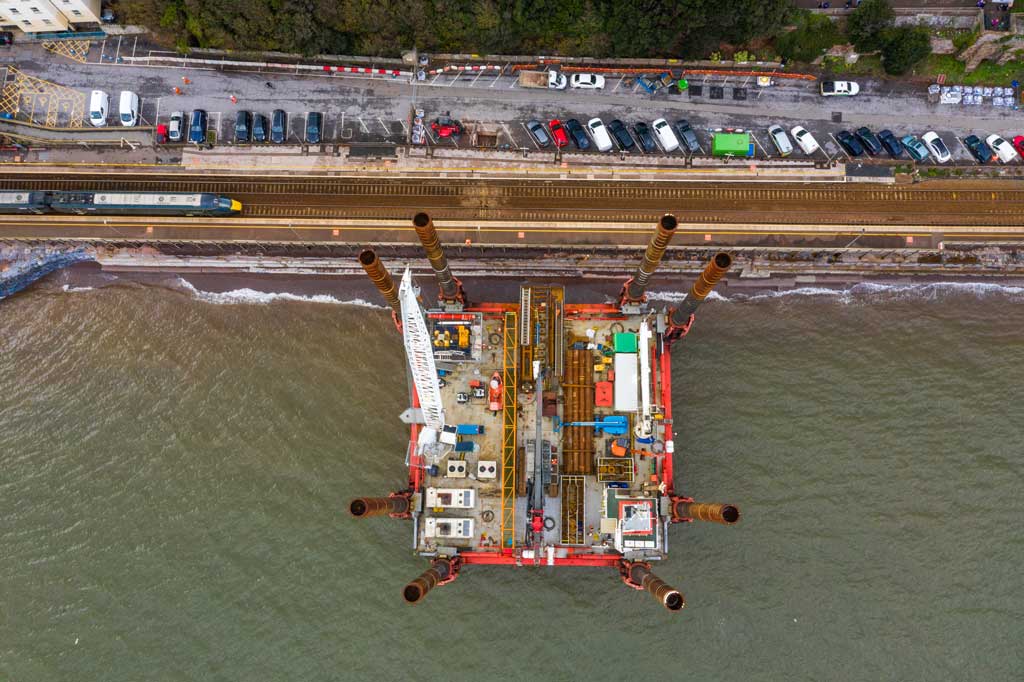
Construction has begun on a new and bigger sea wall at Dawlish to protect the railway and town from rising sea levels and extreme weather for the next 100 years.
In 2014, a storm caused a stretch of the Devon coastal railway to collapse into the sea – cutting off the South West peninsular from the rest of the line.
Strong winds and high seas led to the wall between the sea and railway being breached, with a section of the wall washing away as well as 80 metres of track, platforms at the railway station and sections of the coastal path.
Enjoy more Railways Illustrated Magazine reading every month.
Click here to subscribe & save.
The line was reopened just eight weeks later and marine, coastal and railway engineering experts began drawing up plans for long-term solutions to protect the railway and town.
Network Railway said the construction of the new sea wall, part of an £80 million upgrade, will take around two years to complete.
Dawlish ‘protected for next 100 years’
Ewen Morrison, senior programme manager for the Dawlish sea wall project at Network Rail, said: “We are thrilled to have started work on delivering the next section of this vital upgrade that will protect the rail artery to the South West for the next 100 years.
“Our plans have been drawn up by world-leading engineers and it will provide greater protection to the railway and town from rising sea levels and extreme weather.
“We will continue to update the community with how our work is progressing.”
The first part of the work, from Dawlish station to the Coastguard breakwater east of the station, is expected to be completed in late 2021.
Construction of the final part, between the station of the Colonnade breakwater – which will link up the new wall at Marine Parade – will start shortly after.
A major aspect of the work involves the use of an eight-legged, self-contained walking jack-up barge, known as a Wavewalker – the only one of its kind in Europe.
It will be the first time this type of barge has been used to maintain the UK rail network.
The equipment will be used by contractors BAM Nuttall to safely access the sea face of the railway embankment along Marine Parade and help deliver the piling at the sea wall.
The Wavewalker is able to operate across high tidal ranges, which particularly impact the south Devon coastline and would otherwise restrict the number of hours available to safely work on the sea wall.
Rail minister Chris Heaton-Harris said: “I’m really pleased to see that work is starting on the next phase of the sea wall, and that the innovative Wavewalker is being used to construct it – a first for UK rail.
“Our investment will provide a resilient railway for generations to come, and forms part of our commitment to deliver reliable, punctual journeys across Devon and Cornwall, helping the South West build back better, supporting the local economy and tourism.”
Once complete, the 415-metre section of the new sea wall will be higher than the existing wall and will have a curved edge to send waves back towards the sea.
It will also feature a high-level, wider and safer promenade, pedestrian access to the beach and an accessible station footbridge with lifts.
Anne Marie Morris, Conservative MP for Newton Abbot, said: “I very much welcome the beginning of this part of the resilience work at Dawlish which will safeguard the line for decades to come, bringing with it an economic boost for the local economy and that of the wider South West.
“I very much encourage constituents to make use of the Network Rail information point for any updates or queries they might have.”





